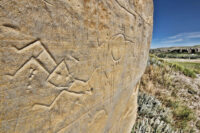‘You can’t rebuild a mountain’: fallout of open-pit mining discussed
By Lethbridge Herald on October 3, 2020.
Tim Kalinowski
Lethbridge Herald
tkalinowski@lethbridgeherald.com
The Southern Alberta Council on Public Affairs welcomed Katie Morrison, conservation director with the Canadian Parks and Wilderness Society Southern Alberta (CPAWS), to its weekly YouTube livestream speaker series on Thursday.
Morrison warned the Kenney government’s plans to open up more formerly protected areas for coal mining will have serious consequences for the health of southern Alberta’s headwaters and sensitive ecosystems, the overall health of local residents, and will severely undermine sustainable local economies like cattle ranching and farming.
The only ones to really benefit from current plans to set up more open-pit mines in the region’s sensitive headwaters, said Morrison, were the Australian billionaires who run these mining companies and the Asian countries who use the coal.
“Once the coal is out of the ground it will be shipped overseas, largely to Asian steel-making markets,” she said. “So most of the projected economic value will flow out of Alberta and out of Canada all the while undermining the existing and growing sustainable economies, affecting the livelihood of ranchers, agriculturalists, outfitters, the outdoor recreation industry, and other land users.”
Morrison acknowledged there may be some short-term benefits for a few Albertans. But future generations, she warned, will have to deal with open holes, lost ecosystems and contaminated water where there used to be mountains.
“So what about reclamation?” she asked rhetorically. “We hear that as a solution to make us feel better. And, yeah, they can put back some of the soil, plant some grasses and other things back, but we can never actually restore these sensitive grasslands or alpine ecosystems back to what they were before and supporting the same diversity of life. And you can’t rebuild a mountain.”
Morrison, who used to work in oilsands reclamation in the north before moving to the southern Alberta region to take up her current position with CPAWS, explained the process of how open-pit mining works.
“Explosives and machinery are used to access the coal deposit,” she said. “There are various coal seams throughout the mountain, and they take off the overburden, the soil and rock, to get to those coal seams. That creates a lot of waste rock which essentially piled in adjacent valleys. Water is used to wash the rock and process the coal through, and then that water is put in sediment containment ponds. So essentially the mountain comes down, the valley comes up, and you are left with a sediment pond often filled with contaminated water.”
Morrison said those were the immediate visible impacts of this type of mining, but there were also longer-term health consequences for those working in or living near these mines.
Citing a health study from the Appalachian region of the United States where this type of coal mining is more common, Morrison outlined some of those health risks, which include higher rates of cancer, higher heart and lung disease rates, higher kidney disease rates, higher rates of birth defects, and higher levels of impaired functioning due to chronic health problems.
“It is associated with a set of serious health problems, largely from the dust of silica, sulfur, organic carbon, aluminum, iron, trace elements that people are breathing in and absorbing,” she explained. “This is not just the miners who are working in the coal mines, it is the communities around the coal mines irrespective of whether they are involved in the mining. Some of these studies show the economic costs of the health problem in Appalachian coal-mining areas are more than five times greater than the economic benefits of mining.”
Morrison pointed at the UCP government’s June 1 cancellation of the long-standing 1976 Coal Policy as Alberta’s guiding document for opening the floodgate to more and more potential mining operations in southern Alberta.
“At the time (the Coal Policy) was created with extensive public consultation to create a fair balance between environmental protection, economic development and the social needs of Albertans,” she said. “They rescinded that policy without any public consultation with Albertans. Although we know now to at least seven months to a year before cancelling that policy, they were having conversations with coal companies.”
Morrison said such actions displayed the current government’s shortsighted thinking on the issue.
“We can’t build a sustainable future by diversifying from one high-risk, non-renewable resource to two high-risk non-renewable resources,” Morrison emphasized. “That’s not to say resources have no place in our economy, present or future, but they must be well-regulated, in the right place, provide more benefits than risks, and not undermine sustainable growth.”
Morrison told SACPA livestream viewers it is paramount for those opposed to this type of coal development to make their voices heard loud and clear on the issue. She said the first battleground for this will be on Oct. 27 when Benga Mining Ltd. goes before a public hearing of the Joint Review Panel to make its case as to why it should be allowed to open its Grassy Mountain mine. The public hearing will be streamed on YouTube live and also live streamed on Zoom. CPAWS has been granted intervener status in the case.
Morrison hoped many Albertans would contact their local MLAs, write letters expressing their opposition to the project, and organize various campaigns and community actions to let the Joint Review Panel know they are not OK with these types of coal mining operations being set up in the sensitive headwater regions of the province.
“This is the first project,” Morrison explained, “and if Grassy Mountain is approved it signals to other companies that governments consider coalmining an appropriate use of this (sensitive) landscape. And it makes it more likely that other projects will also move forward. Simply put, Grassy Mountain is the first domino of coal mines that could change Alberta’s headwaters forever.
Follow @TimKalHerald on Twitter
23-22




